When I bought my first NFT, the whole thing was complicated. It still is, and it’s risky. Most NFTs are art, so the value is in the eye of the beholder (and the market). While that means you can make a lucky million, you can also be left holding a bunch of NFTs that were supposed to be good, but..weren’t. That’s how I did it; making a ton of bets, playing fast and loose, and frankly, losing most of the money I’d set aside to “learn the game”. A few NFTs paid out well, but I was mostly left with a collection of jpegs I’d rather hide than display.
That’s not a great experience, and I don’t want you to have to pay the same price to learn the same lesson. Still, NFTs hold a lot of promise. They are a new form of digital proof. In the world we’re heading into, I think the ability to hold, use, and understand that proof will be a valuable skill. I’d like to help you learn it.
The Gristle King NFT, which I call the G‑Unit, is a way for you to enter into the world of NFTs and make sure you get something for your money beyond a jpeg.
When you buy and hold a G‑Unit NFT, you get the following things:
- Access to the Gristle King courses (the Helium Basic Course and the HeliumVision MasterClass), which is a $199 value.
- A month’s worth of entry into the Gristle Crüe ($49 value), my private Discord members channel where we meet once a week on Zoom to talk about the latest in Helium with experts in the field.
- Access into a special channel on the Gristle King Discord called #nft-holders. Unlike many NFT projects I’ve seen, I’m not going to bullshit you with a bunch of hooey about how access to that channel will make you sprout wings and shit glitter. It won’t. It will, however be a place where you can find other people who are very likely to be interested in both Helium and NFTs, and I think that intersection will be interesting. Value in that one is unknown.
So, depending on what ETH is when you buy the NFT, you should get pretty close to the same value if you’d spent money on the courses and to join the Crüe.
I’m only creating 749 of the G‑Units, which is a small run in the world of NFTs. Projects usually create at least 1,000 if not 10,000 NFTs. I wanted to keep the group manageable as well as make it semi-exclusive. I’m under no illusions that the thing will “mint-out” in minutes, but I thought it’d be fun if you got to have something that no more than .00000096% of people on the planet will ever have. For that stat, I used a world population of 7.753 billion.
If you’d like to get an NFT, hit the big blue button.
If you’d like to know a little bit more about minting and how to use the NFT, watch this.
Once you have the NFT, here’s how to access the benefits.
If you want to see the mechanics behind how this NFT came into existence, keep reading.
I started by buying a CryptoHoot, which is an NFT from a totally separate collection. Here’s a “Hoot”.
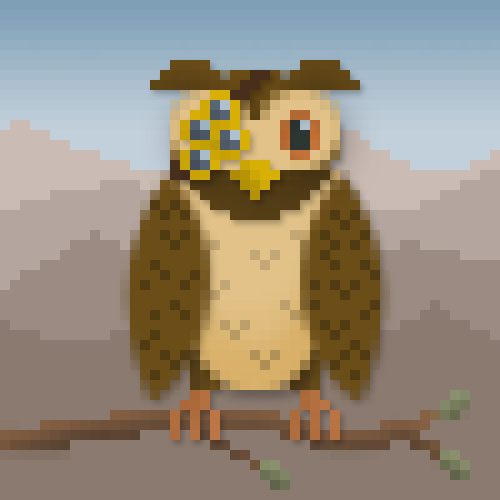
Now, you may be asking, “Nik, why the heck are you showing me an owl? I thought we were talking about G‑units?!”
Well, this particular NFT gives you access to both a Discord server (which pretty much every NFT does) AND a tool called Shufflemint.
Shufflemint is the thing that makes this NFT special, at least for me. Shufflemint makes it so you can add a bunch of different layers of art, randomly shuffle those layers, and create a bunch of unique NFTs. That’s pretty cool, and that’s how the G‑Unit is made.
Here’s how it starts, with a clean slate. You can see I’ve already created a project here, called “GK”.

Inside that “Project” are a few different sections. Each section builds on the last. First, you load your assets (the pieces of each image that make up a final NFT image) into Asset Staging.

This NFT is a pretty simple project; 6 layer categories, each with a few different options. There are pancake hats and pink mohawks, different eye styles, bows & arrows and burritos & coffee. If you just threw it all in together it’d be a jumble of eyes and backgrounds and mohawks and pancakes, like this.
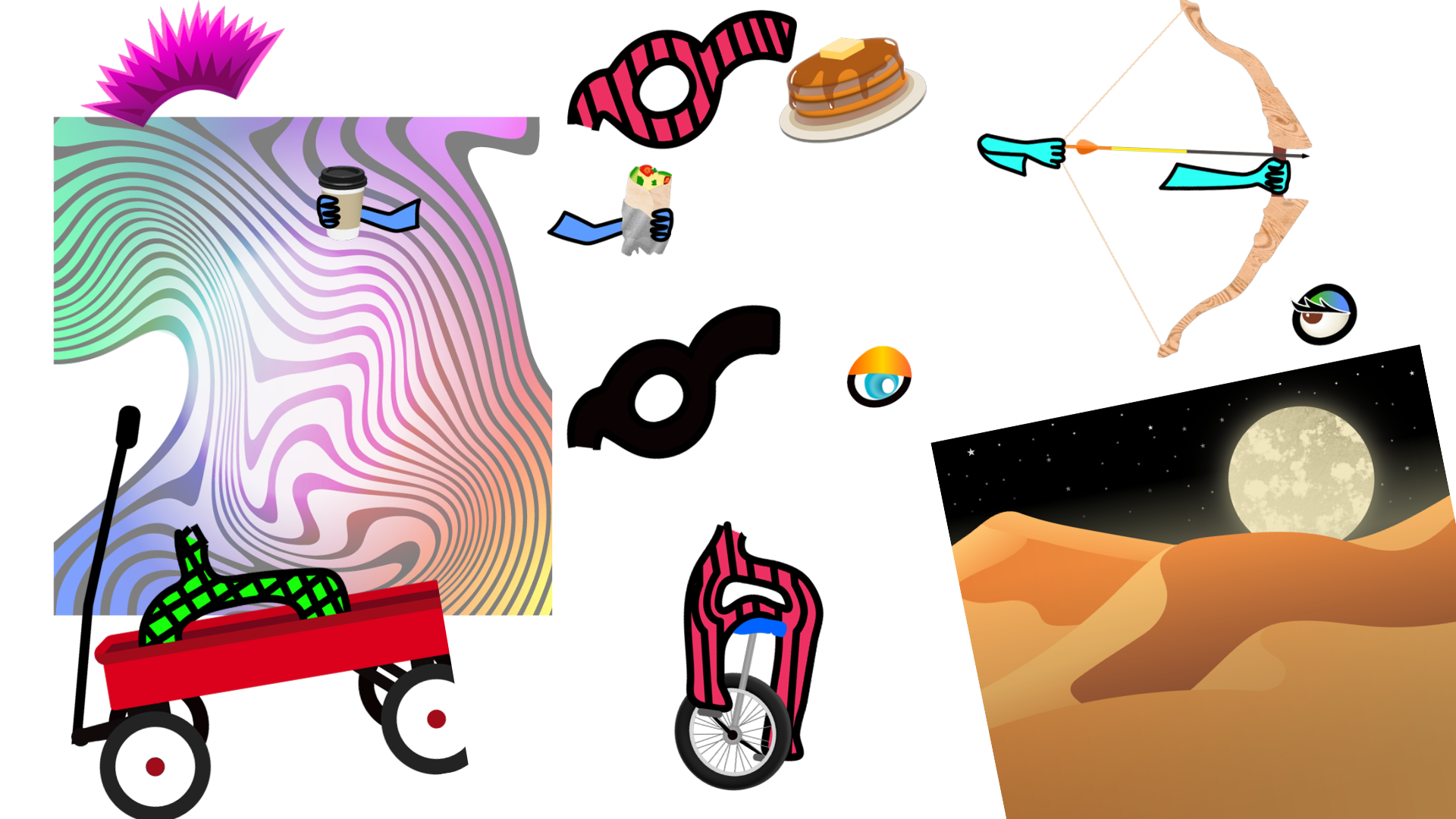
Nobody wants that, so you’ve got to organize it a little bit. Once your assets are in and labeled, you’ll sort them into the correct layer order (background, eyes, heads, arms, etc).
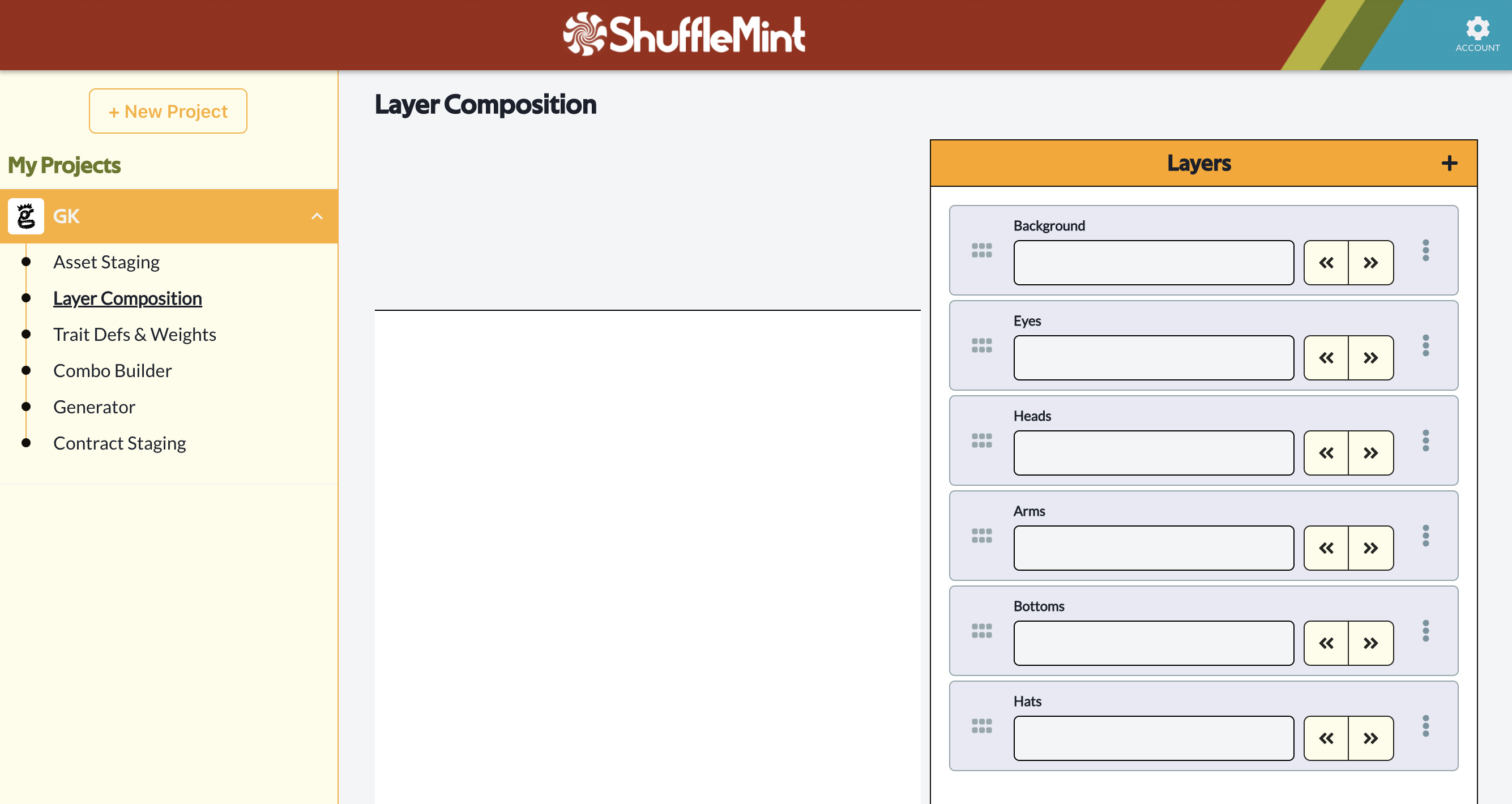
That can be confusing for those of use who aren’t super visual people (like me), and this took me a while to figure out which layer should go where so it doesn’t hide or get hidden by another layer. A fun puzzle! Once you have the layers ordered correctly, you can use those right and left arrows in the Layers column to flip through all your potential options. It might take years to see all possible options, so I just went through a few each time to confirm I had my layers in the right order. Here’s an example of what it looks like when you choose a specific Asset from each Layer.
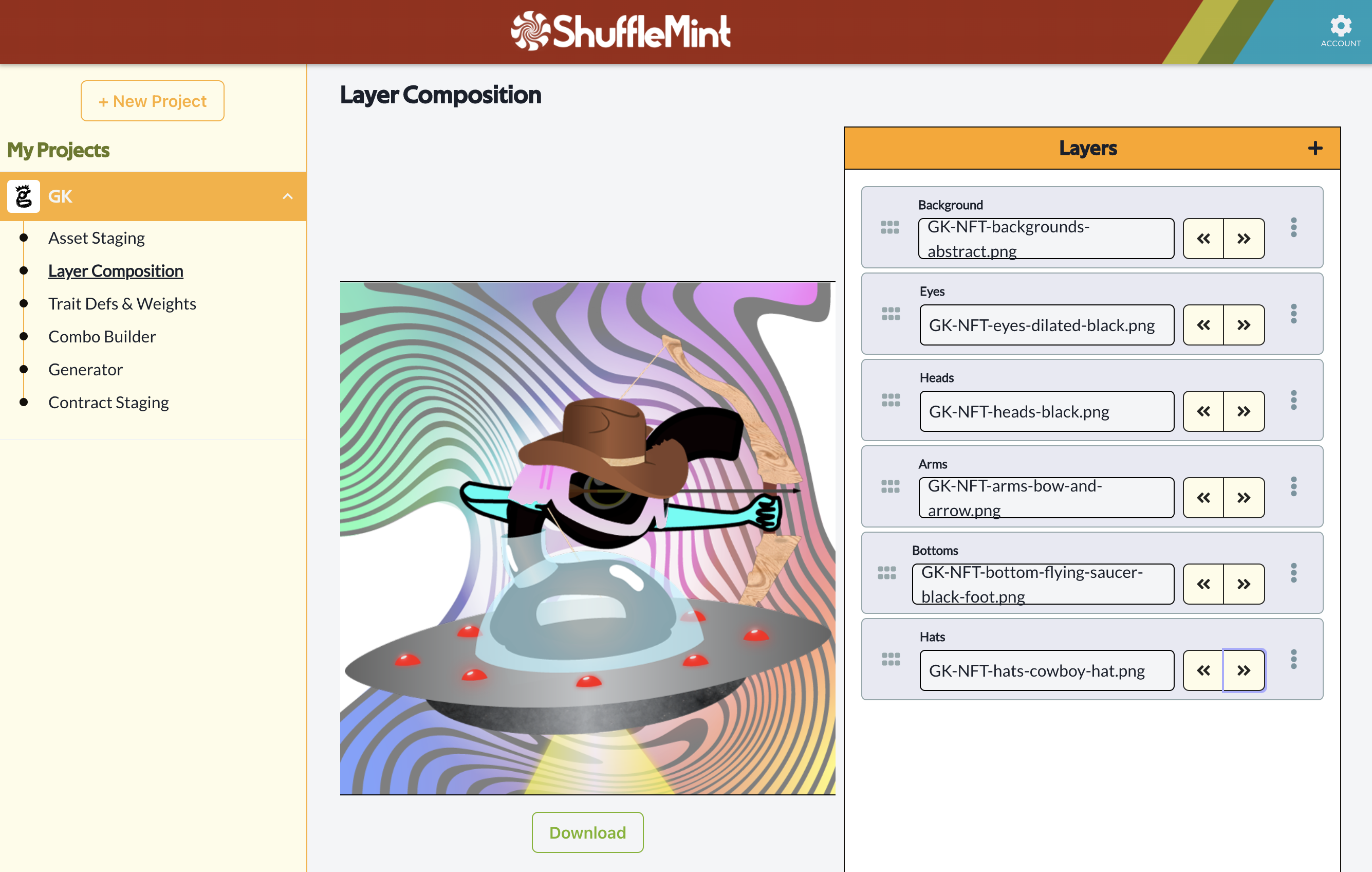
This really helps you see if you’re getting it right!
From there, you go through and give your Traits “Definitions” and “Weights”. A Definition would be what I’d think of as a Layer Category, like Background, or Eyes, or Heads.
A Weight is the value for the relative frequency of a specific layer. For example, the Weight of the Abstract background (what you see in the above generated image) is 20. That means you’ll see it 20% of the time, so it’s relatively rare. Here are the Weights for the Trait called “Background”.

The next part, “Combo Builder” isn’t ready for prime time yet, so we’ll go to the fun part, Generator!
In the Generator section, you pick how many NFTs you want to Generate, then hit the button. Easy (and fun)! Here’s a random example of generated G‑unit NFTs (which may or may not be in the final collection.) Fun fact: Even though it looks like “body” is all one thing, every “body” is actually made from a “bottoms” and “colors” layer. The “colors” layer stood in for the color of the body. For a while we thought it might be cool to mismatch the two, but I wanted at least some uniformity in this, so all the bodies are the same color, top & bottom.
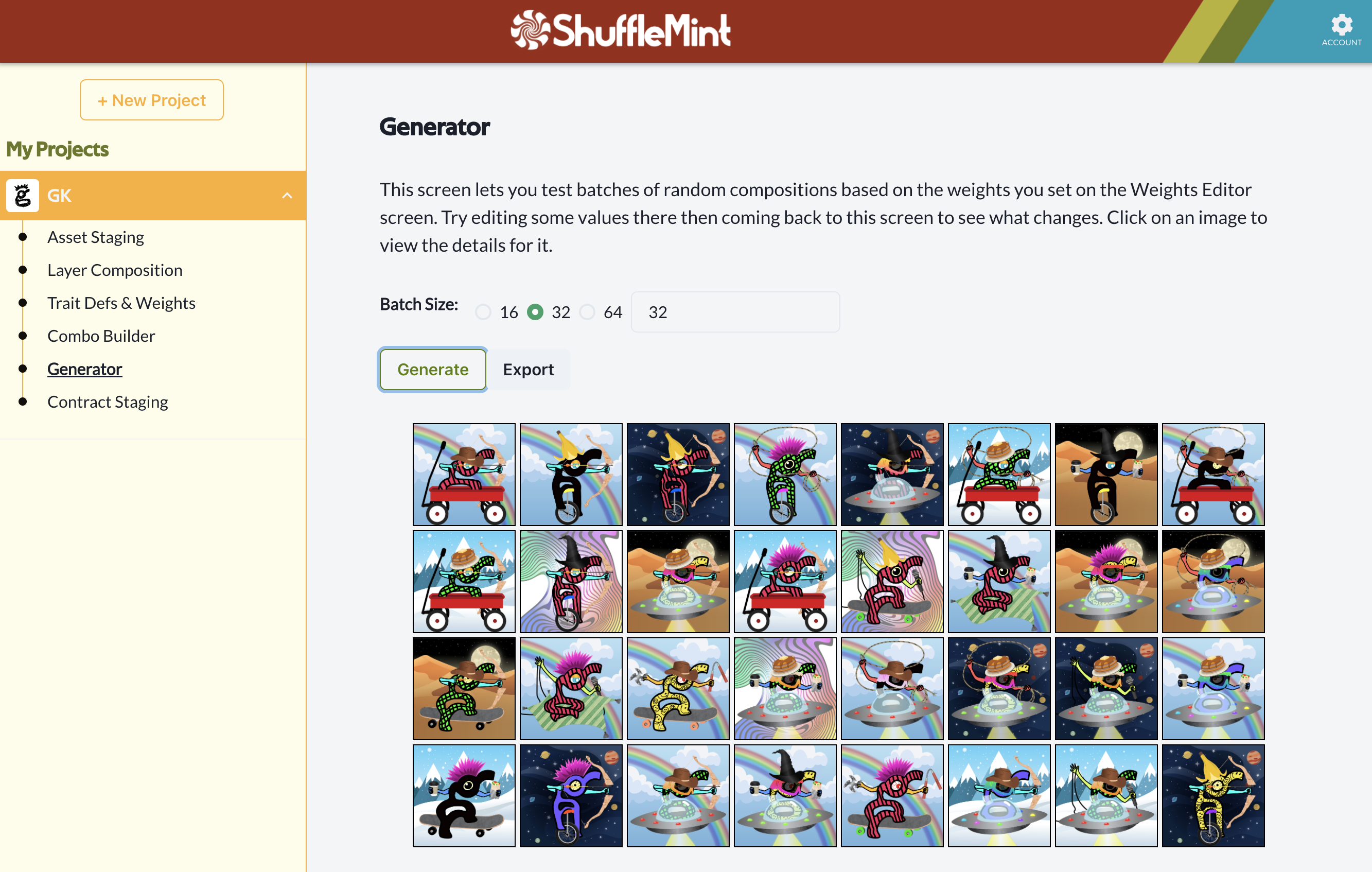
From there, you can launch it yourself, or, if you’re like me and prefer to let professionals handle that, you reach out to the ShuffleDAO for help.
Now, you might think art generation piece is the end of it, but wait, there’s more! One of the coolest things about NFTs (and really, web3) is how much collaboration can happen between strangers, and how transparent everything is.
In this case, I’ve never met any of the ShuffleDAO people in real life. We’ve talked on Discord, and we’ve chatted on Zoom, and we’ve even done a YouTube Live together, but I’ve never met ’em!
Still, we’re working together on this project as strangers who’ve decided to harness in together for a bit and pull for a common goal. As part of that, the contract that gets executed when the G‑Unit goes live slices off a share for them and the ShuffleDAO project, and the way it does it is REALLY cool!
You see, the ShuffleDAO goal (in part) is to make easy for people like me to create and use an NFT as part of a community. When you buy a G‑Unit NFT, part of the ETH you spend goes to ShuffleDAO for orchestrating the project. Part goes to buy their token, which is called $MINT, and then you get that $MINT dropped into your wallet.
Think of $MINT as rewards points; you can use it anywhere in the ShuffleDAO system, and you get it for free when you buy a GK NFT.
Here’s the breakdown:
70% to GK
20% to ShuffleDAO
10% to $MINT, which you get back in your wallet.
So that’s how the whole G‑Unit NFT thing is working. I’m super psyched to launch this, and I’m pumped to meet all the holders in the Gristle King Discord #nft-holder channel, which right now is empty, just waiting.
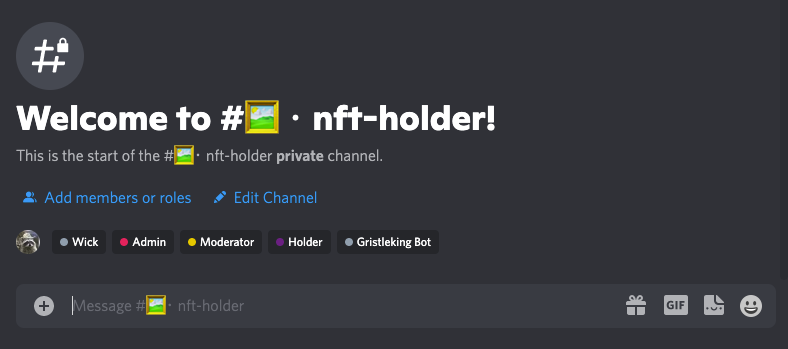
Will I see you in there?
Hey, before I sign off, let me put a disclaimer in here: NFTs are volatile. You could lose all the money you put into this or any NFT (or crypto) project. You’ll get charged with “gas fees” every time you do an ETH transaction, including buying this NFT, which will increase the cost of the NFT. I’m not a lawyer, or an accountant, or a financial advisor. None of this is anything close to professional advice. Never spend any money you’re not willing to lose in the world of crypto. Do your own research and be careful out there.
Ok, that wraps it. Drop any comments, questions, feedback below, I’m always looking to learn & share lessons to improve. Rock ‘n roll!

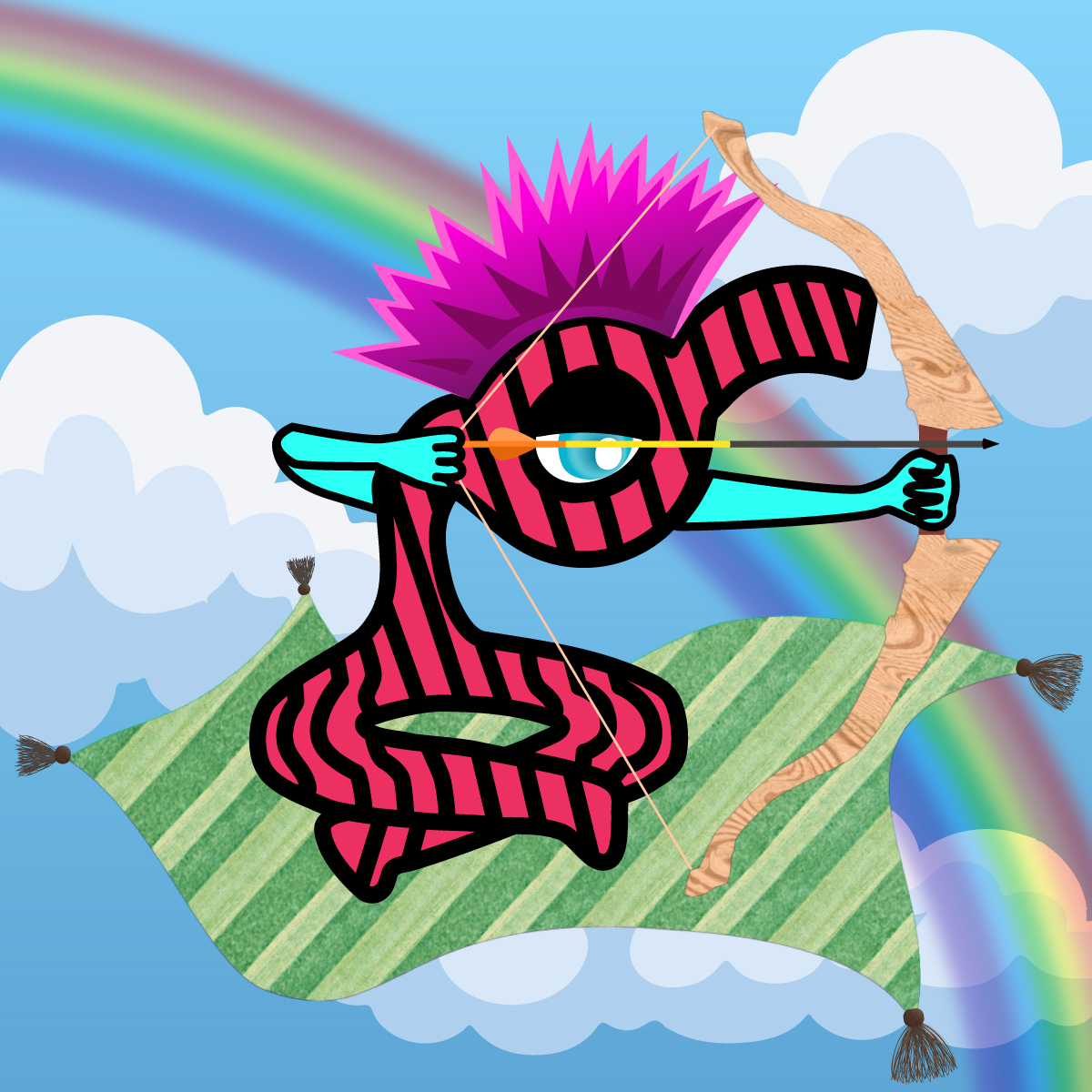
Leave a Reply